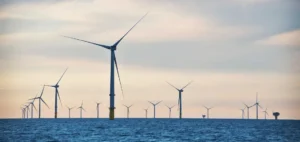The Nantes administrative court of appeal has annulled the environmental permit for the installation of three wind turbines in Porspoder, in the Finistère region. This decision, rendered on October 1, 2024, highlights the challenges related to the development of renewable energies in areas with significant heritage value. The project, initially authorized by the Finistère prefect in July 2022, was challenged due to its proximity to the Kergadiou menhirs, which are over 4000 years old and classified as historical monuments.
Conflict Between Historical Heritage and Energy Development
The Kergadiou menhirs, located just 540 meters from the site of the third planned wind turbine, have been listed as historical monuments since 1883. The court ruled that the installation of these wind turbines would have a degrading visual impact on these archaeological landmarks, thus altering the perception and scale of these megaliths within their environment. This conflict between heritage preservation and energy project implementation is a recurring issue in France, where infrastructure development must balance the demands of energy transition with the protection of cultural assets.
The court also highlighted that other megalithic sites, located within a radius of 1,000 to 1,750 meters, would be affected by the wind turbine installation, including the Traon-Igou menhirs, the Mesdoun menhirs, and the Mezou Poulyot dolmen. Local heritage preservation associations, such as the Association for the Protection of the Aber Ildut and the Association for the Safeguarding of Iroise Landscapes, supported the appeals filed by residents to cancel this project.
Local Opposition and Overlooked Negative Opinions
The prefect’s decision to maintain the project despite numerous negative opinions was a major point of contention. The architect of French historical buildings, the municipalities of Plourin and Lanildut, as well as the investigating commissioner, had all expressed concerns about the project’s impact on the landscape and heritage. The site, located at an altitude of 50 meters and three kilometers from the coast, offered direct visibility to several of the region’s emblematic landmarks, including the Iroise Marine Natural Park, the islands of Ouessant and Molène, and the Four lighthouse.
According to the court, the presence of wind turbines would have disrupted the readability of the protected landscapes of the Saint-Laurent peninsula and the Landunvez tourist route. This decision reflects a broader trend where courts are increasingly prioritizing the protection of heritage sites over industrial projects, particularly in regions like Brittany, where historical heritage is closely tied to local identity.
Impact on Wind Energy Development in France
The cancellation of this wind project is not an isolated case. France has experienced several similar incidents, where wind farm deployment has been suspended or halted due to its impact on heritage or on landscape conservation. This creates a paradoxical situation for renewable energy developers, who must navigate between the imperatives of the energy transition and local regulatory constraints. The current legal context could potentially slow down the expansion of onshore wind energy, at a time when the country aims to strengthen its renewable production capacity to meet its decarbonation targets.
In 2023, over 40 wind projects were blocked by similar court decisions, highlighting the need for developers to better anticipate heritage risks when planning new projects. This situation has led to a revision of environmental assessment procedures to better integrate heritage issues at the early stages of project development.
Industry players are now calling for a clearer legislative framework to reduce legal uncertainties and facilitate the development of infrastructures while respecting cultural heritage. This case underscores the importance of finding a balance between the growth of renewable energies and the preservation of historical elements that shape local landscapes.





















